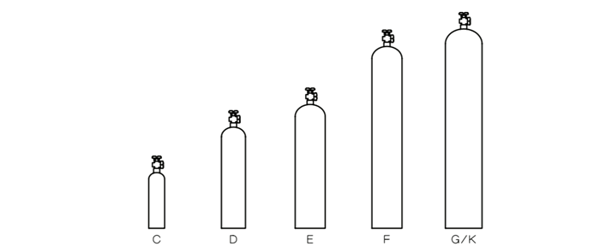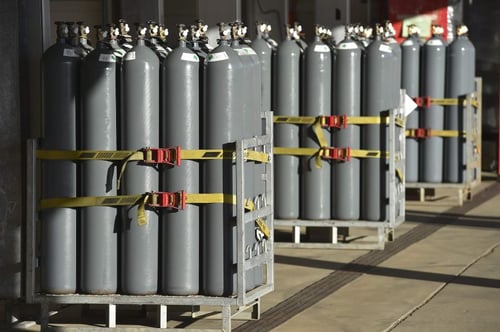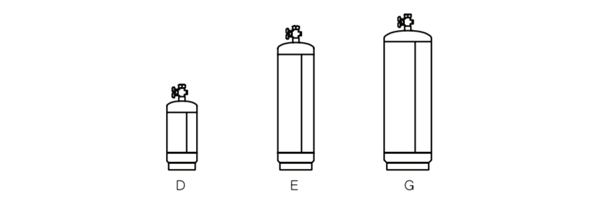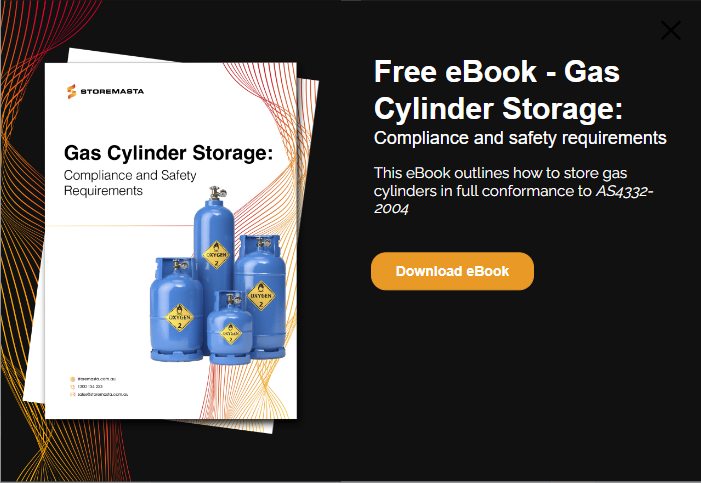Searching for more information about gas bottle sizes? In Australia, compressed gases are stored in three different cylinder types, high pressure industrial gases, LPG and acetylene. Each of these cylinder types has a range of standard sizes, which are denoted by a letter code. In this post, we outline the different gas bottle types and sizes (capacity/dimensions) as specified by the Australian Standard AS 4332-2004 - The storage and handling of gases in cylinders.
REMEMBER: Compressed gases are classified as dangerous goods, as well as hazardous chemicals. If you’re confused about how to manage your safety obligations, you can access our eBook Gas Cylinder Storage: Compliance and Safety Requirements.
High Pressure Industrial Gas Cylinders
High pressure industrial gas cylinders house compressed gases like Carbon Dioxide, Argon, Nitrogen, Helium, Hydrogen, and Oxygen. In Australia, cylinders of high pressure industrial gases come in a variety of standard sizes which are each categorised by a letter code.

From carbon dioxide to oxygen, high pressure industrial gas cylinders are available in Australia in a range of sizes.
These high pressure industrial cylinders are categorised in sizes C through to G/K, and offer a water capacity ranging from 2-3 to 48-50 litres.


REMEMBER: All cylinder measurements are approximate as the sizes and weights will vary depending on the gas type, volume and fill pressure.
LPG Cylinders
LPG cylinders are some of the most common workplace cylinders. From fueling BBQs to powering forklifts, you’re probably already using some of these cylinders in your own workplace.
LP gas cylinders come in a range of sizes, denoted by their own letter code.
Here are a few examples of some LPG cylinder sizes and applications:
- Sizes N and P: home BBQs and camping equipment
- Sizes Q/T and R: powering forklift trucks
- Size S —heating domestic homes and small business, plus premises operating commercial gas appliances; and
- 90kg tanks — permanently installed and filled onsite at residential homes or businesses operating commercial gas appliances


REMEMBER: LPG gases are highly flammable, odourless, and asphyxiants. They should be stored outdoors away from heat and other ignitions sources (including static electricity).
Acetylene Cylinders
Acetylene is an industrial gas used for cutting applications and welding steel. As it’s an extremely volatile gas, acetylene must be dissolved in a solvent and stored in a special cylinder containing a porous mass.

Cylinders of acetylene must be stored and handled carefully to reduce the risk of static and shocks.
Acetylene cylinders come in three sizes, ranging from size D (10 litre water capacity) to size G (50 litre water capacity).
Below are the following standard sizes of cylinders for acetylene:


REMEMBER: Acetylene cylinders have additional precautions and safety requirements for usage and storage. These include not approaching a cylinder if there is excessive heat or a workplace fire, handling acetylene cylinders to prevent shocks, storing cylinders upright, and opening valves slows to reduce the risk of static electricity.
Sorting Out Gas Bottle Sizes In Australia
Do you need know how to safely store and use gas bottles at your workplace? Why not download our free eBook free eBook Gas Cylinder Storage: Compliance and Safety Requirements? Our guide offers detailed information about the requirements of the Australian Standard in a simple, easy-to-read format. Access your own copy today and get your workplace 100% safety compliant.
Like what you’re reading? Keep learning about gas cylinder safety and storage with our helpful blog series:
Why gas cylinders should be stored outside
Segregation requirements for storing different classes of dangerous gas
Controlling gas cylinder hazards
Compressed gases in cylinders: when do you need a risk assessment?
Joining the team as a Dangerous Goods Storage Consultant, Melissa Hampton became Storemasta's Marketing Manager in late 2021. With extensive knowledge and experience in chemical compliance, Melissa is responsible for leading the Marketing team and helping shape their marketing strategy. In her spare time, you can find Melissa hiking, swimming and enjoying the great outdoors in beautiful north-west Tasmania.
